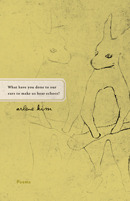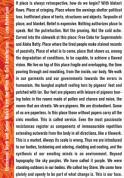 Poet Arlene Kim rocked my literary heart at Richard Hugo House’s Lit Series earlier this year with an erasure poem displayed entirely in slides. This haunting response to the abuse of girls changed my conception of poetry. I bought her book, What have you done to our ears to make us hear echoes?, immediately and have carried it with me every day since.
Poet Arlene Kim rocked my literary heart at Richard Hugo House’s Lit Series earlier this year with an erasure poem displayed entirely in slides. This haunting response to the abuse of girls changed my conception of poetry. I bought her book, What have you done to our ears to make us hear echoes?, immediately and have carried it with me every day since.
Although the video of that evening’s performance is locked somewhere in a vault and I cannot share it with you, I can share this book and what it taught me about poetry. If you’re a returning reader to this blog, you know that I’m fascinated with poetry, but I am only recently learning to write it. So when I read a book like Kim’s, I am reading as much for what I can learn from it as I am for the beauty of language.
What Poetry Sounds Like
I’ve been reading Robert Pinsky’s The Sounds of Poetry lately. In fact, it was his discussion of the way tension carries across a line that taught me to better hear poetry. Kim utilizes that tension incredibly well. In “Hollow Tongue” she writes, “The dead can speak / any language, I’d imagine,” and I became enraptured with the way the line breaks. I’ve run it over and over my tongue just to capture the way, as Pinsky has taught me, the line slows the sentence down and the sentence speeds the line up.
Another favorite selection I’ve been studying for line breaks is “Paper Suns,” where Kim writes, “My love. I tended him / after he fell. His charred wing stumps, / his elegy of scabbed feathers. Only then”. The line breaks give an extra charge to a poem already full of rich language and evocative imagery.
The Many Shapes of a Poem
My knowledge of forms of poetry is limited. What I can tell you is that Kim considers the entire page when she writes her poems.
The first poem in the collection, “Rot,” is a series of conventional paragraphs spread across multiple pages whereas “Wind,” also a poem set in paragraph form, gusts across the pages it covers with shifting margins and alignments. “Spool, Book, Coin” is written in very short lines that, according to the endnotes, mimic the wavering walk of a child. The way each of the poems in this book is laid out is so carefully considered and unique to each instance, that I wanted to (and will in the coming days) study them over and over to learn precisely how the layout and syllable counts affect my read of each poem.
Recurring Imagery
There are many images that Kim returns to again and again throughout the book including the woods, hair, and birds. It was the Biblical apple, though, that caught my attention. This was in part because it’s a relatively accessible image and occurs very early in the book, but it was also so lusciously invoked that I wanted to think about it over and over. “Rot” starts, “Begin / An apple. Experts agree that it starts with an apple.” The language was so simple and yet I was so firmly entrenched in Eden. I wondered how she did that and if I had somehow too firmly committed to one interpretation. The poem goes on in the next section:
A tempting red apple sits on the table. The person sees red, sees just the skin of the apple—not the flesh, or the seeds, or the table, or even the room. And certainly not the story. Not yet. The apple is of color. The person is of color. The apple has the property of redness. The person has the property of color.” – Arlene Kim, “Rot”
And so the poem isn’t just about sex and temptation but it’s about surfaces and the way we become beguiled and misled by them. There are many, many things happening beneath the surfaces of Kim’s poems and I look forward to discovering more as I read them. I was grateful for the notes she provides at the end of the book, but the poems are strong enough to do without them if you choose.
Now that I’m getting over my obsession with getting poetry “right” (damn you undergrad English courses), I’m really starting to enjoy reading poems. My favorite prose is usually about the language of a piece and concision anyway, and who spends more time crafting language than poets?
I recommend Arlene Kim’s What have you done to our ears to make us hear echoes? for poetry newbies like me and also for my more educated poet friends. I learn from you, so please share your thoughts about the craft of this book with me in the comments below. And if I ever find that video of the erasure poem on the web, I’ll post it here.
If this review made you want to read the book, pick up a copy of What have you done to our ears to make us hear echoes? from Bookshop.org. Your purchase keeps indie booksellers in business and I receive a commission.
 When I requested a review copy of Occasional Work and Seven Walks from the Office for Soft Architecture by Lisa Robertson, I was working as the managing editor of an architecture magazine while earning my MFA. The irony of my experience was how many architects used convoluted and turgid language to describe designs that were pared down to their purely minimal essences. The days I spent sorting through jargon like “fenestration” and “tectonics” were great training for nights spent finding the clearest way to communicate an idea in my own writing.
When I requested a review copy of Occasional Work and Seven Walks from the Office for Soft Architecture by Lisa Robertson, I was working as the managing editor of an architecture magazine while earning my MFA. The irony of my experience was how many architects used convoluted and turgid language to describe designs that were pared down to their purely minimal essences. The days I spent sorting through jargon like “fenestration” and “tectonics” were great training for nights spent finding the clearest way to communicate an idea in my own writing.